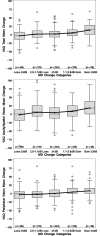Estimating minimally important differences for two vision-specific quality of life measures
- PMID: 24906863
- PMCID: PMC4095718
- DOI: 10.1167/iovs.13-13683
Estimating minimally important differences for two vision-specific quality of life measures
Abstract
Purpose: To estimate minimally important differences (MIDs) for the Visual Activities Questionnaire (VAQ) and the National Eye Institute-Visual Function Questionnaire (NEI-VFQ).
Methods: A total of 607 subjects with newly-diagnosed open-angle glaucoma (OAG) was enrolled in the Collaborative Initial Glaucoma Treatment Study (CIGTS) and randomized to initial treatment with medications or surgery. Subjects underwent an ophthalmic examination and telephone-administered quality of life (QOL) interview before randomization and every six months thereafter. The VAQ and NEI-VFQ were used to assess participants' perceptions of their visual function. Clinical measures included the mean deviation (MD) from Humphrey 24-2 full threshold visual field (VF) testing, and best-corrected visual acuity (VA) measured using the Early Treatment Diabetic Retinopathy Study (ETDRS) protocol. Anchor-based (using MD and VA) and distribution-based methods were used to estimate MIDs.
Results: Anchor-based cross-sectional analyses at 66 months follow-up found a 10-letter increment in better eye VA corresponded to MIDs of 5.2 units for VAQ and 3.8 units for NEI-VFQ total scores. A 3-dB increment in the better eye MD yielded MIDs of 2.6 and 2.3 units for the same two questionnaires. In longitudinal analyses, MIDs for the VAQ were 3.2 units for a 10-letter change of VA and 3.4 units for a 3-dB change in the MD. Distribution-based MIDs were larger.
Conclusions: A range of MIDs for the VAQ (2.6-6.5 units) and NEI-VFQ (2.3-3.8 units) was found. Although similar in magnitude, MIDs were sensitive to the MID estimation method, the anchor chosen, and differences between questionnaires. (ClinicalTrials.gov number, NCT00000149.).
Keywords: CIGTS; MID; NEI-VFQ; VAQ; glaucoma.
Copyright 2014 The Association for Research in Vision and Ophthalmology, Inc.
Figures


References
-
- Revicki D, Hays RD, Cella D, Sloan J. Recommended methods for determining responsiveness and minimally important differences. J Clin Epidemiol. 2008; 61: 102–109 - PubMed
-
- Eton DT, Cella D, Yost KJ, et al. A combination of distribution- and anchor-based approaches determined minimally important differences (MIDs) for four endpoints in a breast cancer scale. J Clin Epidemiol. 2004; 57: 898–910 - PubMed
-
- Jaeschke R, Singer J, Guyatt GH. Measurement of health status: ascertaining the minimally clinically important difference. Contr Clin Trials. 1989; 10: 407–415 - PubMed
-
- Guyatt GH, Osoba U, Wu AW, et al. Methods to explain the clinical significance of health status measures. Mayo Clin Proc. 2002; 77: 371–383 - PubMed
Publication types
MeSH terms
Associated data
Grants and funding
LinkOut - more resources
Full Text Sources
Other Literature Sources
Medical
Miscellaneous

